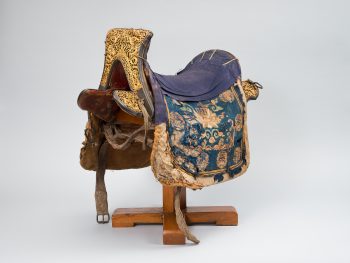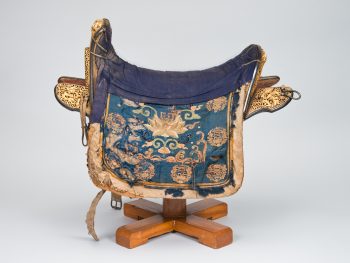Tibet or Mongolia
18th - 19th century









Tibet or Mongolia
18th - 19th century









Such richly decorated saddles were public displays of status throughout the Himalayas, especially in Tibetan and Mongolian cultures where horses played such a prominent role, much as a luxury car does today. The richly decorated face plates on this saddle are made from thick iron, deeply chiseled and pierced, and gilt with a technique known in the West as damascening. The primary motif is long, thin scrollwork framing a pair of four-toed dragons that face a flaming jewel, the most popular motif used to decorate saddles. The cover is decorated with a lotus motif surrounded by smaller roundels with the Chinese character for long life. The wear of the silk saddle cloth reveals its construction, including the use of wool bunting beneath.
While the primary religious goal for followers of Buddhism is enlightenment, many of the practices also serve secular goals related to daily life, including ethical conduct and cultivating well-being.
Mongolians have been widely active in the Tibetan Buddhist world, playing a key role in Tibetan culture, politics, and relations with China. In the 13th century, the Mongol Empire—the largest contiguous empire in world history—facilitated the spread of Tibetan visual culture.
Today, Tibetans primarily inhabit the Tibetan Plateau, situated between the Himalayan mountain range and the Indian subcontinent to the west, Chinese cultural regions to the east, and Mongolian cultural regions to the northeast. During the 7th to 9th century, Tibetan rulers expanded their empire across Central Asia, and established Buddhism as the state religion.
Get the latest news and stories from the Rubin, plus occasional information on how to support our work.